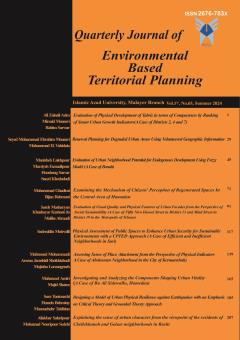Worn Tissue Renovation Planning Using Volunteered Geographic Information (VGI)
Subject Areas :Seyed Mohamad Ebrahim Mousavi 1 , Mohammad Hasan Vahidnia 2
1 - Master of Science, Department of Remote Sensing and GIS, Faculty of Natural Resources and Environment, Science and Research Campus, Islamic Azad University, Tehran, Iran
2 - Assistant Professor, Center for Remote Sensing and GIS Research, Faculty of Earth Sciences, Shahid Beheshti University, Tehran, Iran
Keywords: VGI, Web GIS, ArcGIS Server, crowdsourcing, urban planning, worn-out texture,
Abstract :
Urban decay areas impose significant costs on city management and require proper planning for renewal. Urban managers need precise knowledge of urban areas to formulate renewal plans. Utilizing the capacities of Volunteered Geographic Information (VGI) provides an appropriate response to this need. The aim of this research is to design a Web GIS that leverages Web 2.0 capabilities to collect data from residents of decayed areas. For this purpose, a three-layer architecture, including a GIS server, database layer, and display layer, was designed using technologies such as ArcGIS Server, SQL Server, JavaScript, Dojo, and others. The results of this study show that VGI systems can crowdsource a large volume of data on decayed areas from citizens in the shortest possible time and with significantly reduced data collection costs. This method also helps prioritize urban decay renewal plans.
1. ثابت کوشکی نیان، م.، حاتمی نژاد، ح.، حاتمی نژاد، ح. 1392. سنجش پارامترهای فیزیکی مؤثر در بافتهای فرسوده (نمونه موردی : شهر طرقبه). فصل نامه آمایش محیط، 23(6): 51-78.
2. حسين زاده، پ.، عبدالهي، م. 1394. اشتراک دانش در عصر وب 2. کتاب مهر، 17(18): 81-97.
3. شبیری، م.، شمسی پاپکیاد، ز.، قربانی، ن. 1393. ارزیابی میزان آگاهی کارشناسان نوسازی بافت فرسوده از مسایل زیست محیطی. فصل نامه آمایش محیط، 24(7): 27-40.
4. شکور، ع.، شمس الدینی، ع.، حافظ رضازاده، م.، پاکزاد، س. 1393. بررسی تطبیقی راهکارهای توانمندسازی در بافتهای فرسوده شهری (مطالعهی موردی: محلههای باربند و فاز 1 زمین شهری فیروزآباد). فصل نامه آمایش محیط، 27(7): 79-102.
5. محبی، ر.، قلی زاده، ر. 1385. کاربرد GIS در آمایش سرزمین و مقایسه آن با روش دستی (مطالعه موردی: حوضه آبخیز تیل آباد و مقایسه با حوضه آبخیز کاشیدار گلستان). همايش ملي ارزيابي اثرات محيط زيستي ايران، تهران، 17-18 آذر. 12-18.
6. محمدي، ك.، رضويان، م.، صرافي، م.، غلامحسيني، ا. 1393. شراکت بخشهاي عمومي-خصوصي در نوسازي بافتهاي فرسوده منطقه 9 شهرداري تهران.، اقتصاد و مدیریت شهری، 2(8): 1-19.
7. Cohen, J. E., Sarabia, V., Ashley, M. J. 2001. Tobacco commerce on the internet: a threat to comprehensive tobacco control. Tobacco Control, 10(4): 364-36.
8. Coleman, D., Mclaughlin, D. 1994. Building a Global Spatial Data Infrastructure: Usage Paradigms and Market Influences. Geomatica, 48(3): 225-236.
9. Couclelis, H. 2003. The certainty of uncertainty: GIS and the limits of geographic knowledge. Transactions in GIS, 7(2): 165-175.
10. Fargher, M. 2018. WebGIS for geography education: Towards a GeoCapabilities approach. ISPRS International Journal of Geo-Information, 7(3): 111.
11. Goodchild, M. F. 2009. Geographic information systems and science: today and tomorrow. Annals of GIS, 15(1): 3-9.
12. Horita, F. E., de Albuquerque, J. P., Degrossi, L. C., Mendiondo, E. M., Ueyama, J. 2015. Development of a spatial decision support system for flood risk management in Brazil that combines volunteered geographic information with wireless sensor networks. Computers & Geosciences, 80(1):4-94.
13. Layne, K., & Lee, J. (2001). Developing fully functional E-government: A four stage model. Government information quarterly, 18(2), 122-136.
14. Odendaal, N. 2003. Information and communication technology and local governance: Understanding the difference between cities in developed and emerging economies. Computers, environment and urban systems, 27(6): 585-607.
15. Rahmatizadeh, S., Rajabifard, A., Kalantari, M. 2016. A conceptual framework for utilising VGI in land administration. Land Use Policy, 56(1): 81-89.
16. Reddick, C. G. 2005. Citizen interaction with e-government: From the streets to servers? Government Information Quarterly, 22(1): 38-57.
17. Stehman, S. V., Fonte, C. C., Foody, G. M., See, L. 2018. Using volunteered geographic information (VGI) in design-based statistical inference for area estimation and accuracy assessment of land cover. Remote Sensing of Environment, 212(1): 47-59.
18. Vahidnia, M. H. 2023. Citizen participation through volunteered geographic information as equipment for a smart city to monitor urban decay. Environmental Monitoring and Assessment, 195(1): 181.
19. Vahidnia, M. H., Hosseinali, F., Shafiei, M. 2020. Crowdsource mapping of target buildings in hazard: The utilization of smartphone technologies and geographic services. Applied Geomatics, 12(1): 3-14.
20. Yin, W., Zou, D., Bao, C., Cheng, X., Wu, J., Xiao, W., Lan, Q. 2019. An interactive data visualization design based on WebGIS. In 2019 IEEE 3rd Information Technology, Networking, Electronic and Automation Control Conference (ITNEC) (pp. 2462-2465). IEEE.


